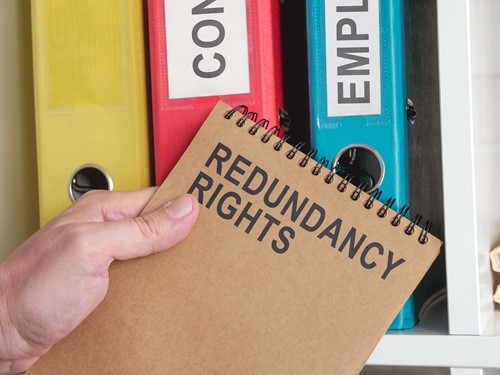Whenever you consider making an employee redundant, you need to follow the correct procedure. This means keeping employees informed throughout the entire process, as required by UK employment law. To do this, you need to issue a redundancy letter at every stage of the process.
Writing such a document doesn’t come easy, particularly when mistakes could lead to an employment tribunal claim. Omissions could fuel workplace tensions and cause issues to escalate.
Using a redundancy letter template will help you avoid such mistakes and omissions. Talk to our contracts and documentation team today and ask for advice on how to use such a form, on 0800 124 4995.
In this article, we will discuss the most important aspects of a redundancy letter from an employer's perspective in the UK.

When to use a redundancy letter
Termination of employment is never an easy aspect to deal with, both for the employer and the employee.
When it comes to a redundancy process, following all the necessary steps will make a real difference. It can lead to the desired outcome of an amicable split, with all parties satisfied with the terms.
The less desirable version of making a staff member redundant would result in them thinking they have been treated unfairly.
Even before you consider handing a letter advising of redundancy, plan how to communicate throughout the process. First, consider a consultation process with your staff face to face, then follow up with written documents.
Verbal communication conveys sympathy and a caring attitude much better than official letters and emails do.
Remember to communicate about it on a need-to-know basis, in one initial meeting with all employees at risk of redundancy. Later, you will hold an individual consultation meeting to discuss the selection criteria with each person involved.

Both verbal and written communications are key to a seamless redundancy process. Sending out letters after talking to your staff members shows that you care, and that you follow due process.
Different redundancy letter types and how to use them
As an employer, you will use three main redundancy letter types, each with a different function. Each of these types applies to a certain stage of the process, as follows:
- Job at risk of redundancy letter
This first letter should inform the employee/s that you consider making them redundant. - Redundancy consultation letter
This second letter will invite all at-risk employees to a consultation. - Redundancy notice letter
This third and final letter should inform each individual that you selected them for redundancy. Also, you need to let them know what the next steps will be.
With all of this in mind, you might wonder how to streamline your use of the above documents. If your business is facing restructuring or closing a production site, you don’t want to spend too much time dealing with complicated papers.
You can use our at-risk redundancy letter template for UK businesses as a starting point. Adapt it to the specifics of your organisation and your situation. It can also constitute the basis for any type of redundancy letter template UK you want to put together.
If you decide to work on your templates, ensure you include all the important information that your staff need to know.
But what should a redundancy letter contain?
Redundancy letter content example
First of all, ensure that you provide the employee with as much information as possible. This way, you give them time and space to analyse, process, and prepare for the end of their employment.
It can make a world of difference for them going forward, in terms of confidence, clarity and mental health.
And, as we’ve mentioned previously, you don’t want to have to deal with disgruntled former employees. An unfair dismissal claim can not only mean loss of time and money but also have a negative impact on your reputation.

As a good rule of thumb when you work on a letter to an employee about redundancy, include the following:
- Reasons for sending out the respective document.
- What alternatives management has considered, as well as what they are doing to ensure a fair process?
- Any updates or changes regarding the stages to follow.
- What the employee’s rights are throughout the process, such as redundancy notice period and redundancy pay.
After you have written a sample letter of redundancy, modify it to suit what needs communicating.
Be mindful not to bombard your staff with unnecessary updates and information though. Remember how much stress and concern this is already causing and avoid adding to it where possible.
What are common redundancy questions
Having supported employers for over 80 years, Croner advisors have seen many questions asked about redundancy, the different types, and different necessary documents. It comes as no surprise that certain aspects tend to confuse both employees and employers more than others.
What documents do you use when you give your staff members the option to offer themselves to become redundant? Do you still need to give them a letter that explains what is happening?
The answer is yes.

If you decide to choose this route, you will most probably ask us how to write a voluntary redundancy letter. Here, you will specify that you offer voluntary redundancy, and clarify the amount you will pay and the redundancy notice period. Send this to all employees.
You might find that a well-worded letter will simplify the proceedings by giving your employees a good incentive.
Our advisors have also come across both employers and employees asking about a redundancy cover letter. This doesn’t refer to the actual process, but rather to what happens after it ends. As your former employees are looking for work, they might struggle to explain what happened in their cover letter.
Give them a hand and help them ahead of time. Do so in a separate form, or in a general reference that you issue for them to use in their job search.
By providing them with a simple guide on how to explain their situation to prospective employers, you can make a real difference in their future.

Get free advice from Croner
No business wants to get to the point where they need to make people redundant. Unfortunately, companies do restructure or even close parts of the business down, and that’s when it happens.
With the ongoing challenges that impact many industries, your business might be facing this possibility sooner than expected.
Don’t risk mistakes that could cost you dearly. When dealing with such a situation, using a good how-to-write redundancy letter template can help ease the process for everybody.
Call our 24/7 HR advice line today so we can help with any documents you need to put together 0800 124 4995.
Related resources
Categories
- Business Advice
- Contracts & Documentation
- Culture & Performance
- Disciplinary & Grievances
- Dismissals & Conduct
- Employee Conduct
- Employment Law
- End of Contract
- Equality & Discrimination
- Health & Safety
- Hiring & Managing
- Leave & Absence
- Managing Health & Safety
- Moving
- Occupational Health
- Pay & Benefits
- Recruitment
- Risk & Welfare





